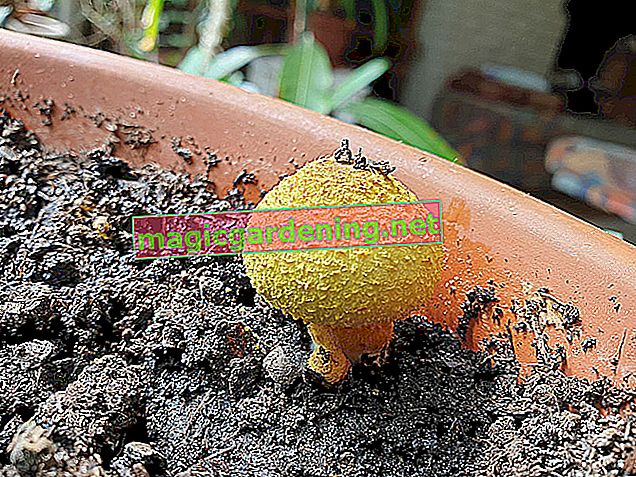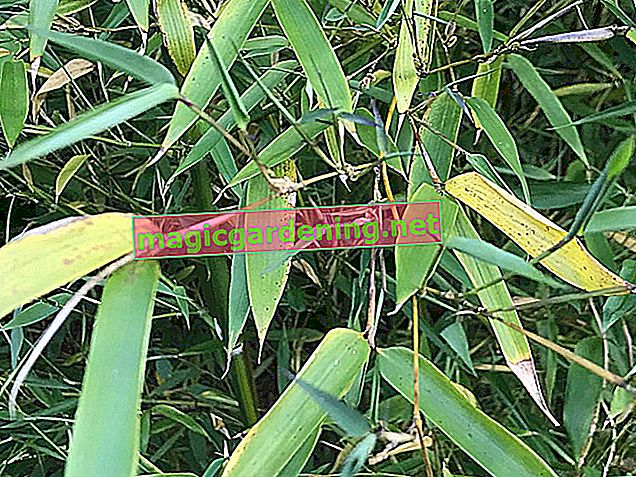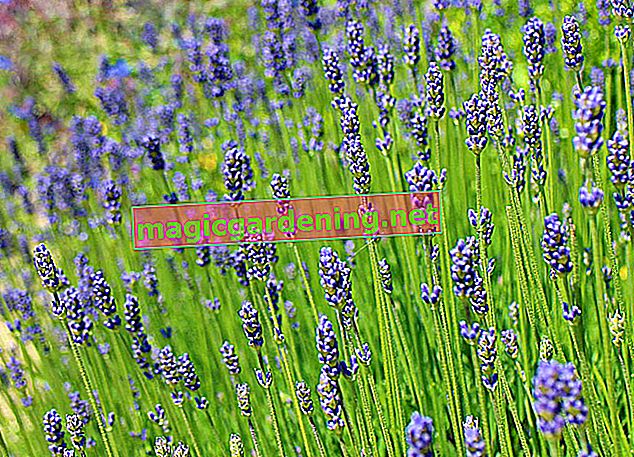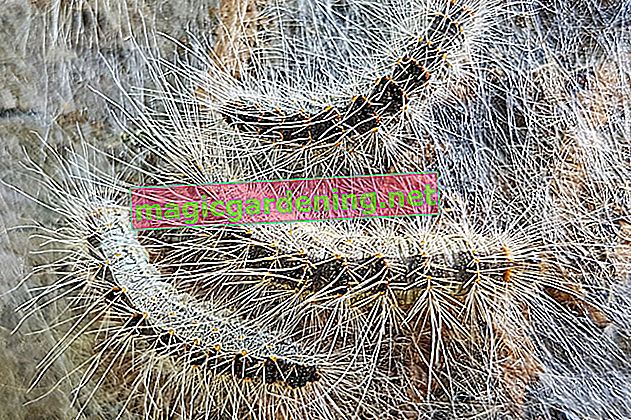
origin
The Christ thorn has the Latin name Euphorbia milii. It belongs to the genus milkweed and originally comes from Madagascar. Here the plant grows in the highlands and in coastal regions. It inhabits forests and grows on granite rocks. In 1821 the plant was introduced to Europe. The German name refers to the thorny shoots that are reminiscent of Jesus' crown of thorns.
also read
- Help, my Christ thorn is getting yellow leaves!
- How should my Christ thorn hibernate?
- How often do I have to water my Christ thorn?
The plant has a geographically highly isolated occurrence. Outside Madagascar, the Christ thorn is only common as an ornamental plant. For this reason it can be ruled out that the plant was used for the wreath of thorns. 2,000 years ago the shrub was still unknown in Asia Minor.
growth
The plant grows as a succulent shrub. It forms thickened cell tissue in which it stores water. The leaves therefore feel fleshy. Through this adaptation, the Christ thorn survives suboptimal conditions in which hardly any rain falls. The shrub forms thorns on the shoots. They developed from leaves in the course of evolution and serve as protection against predators.
The shoots, like the leaves, are thickened and lignified over time. The shrub grows upright and hardly branches out. It grows up to 60 centimeters high.
leaves
Christ thorns develop opposite leaves that sit between the thorns. Their shape is oblong to round. The leaves are light green in color and, like all parts of the plant, have a milky sap that emerges at the base of the stem after being torn off. Avoid direct skin contact with the sap, as it can cause irritation.
blossom
The flowers of the Christ thorns are inconspicuous. The leaves transformed into bracts are conspicuously colored. They appear reddish or white. Their shape is reminiscent of a kidney. They enclose the yellowish inflorescences, which consist of several branched stems. Each stem ends with a tiny flower.
The heyday was based on the rainy and dry seasons of the original distribution areas. In the dry periods the shrub falls into a dormant state. It blooms in more humid conditions between January and March. From October to December it develops flowers for the second time, making it an ideal houseplant with a flowering time in winter.
Is Christ Thorn Poisonous?
Like all milkweed species, the Christ thorn has a sap containing poisonous diterpene esters. These substances irritate the skin and activate dormant cancer cells. If the skin comes into contact with the milk, the risk of skin cancer can increase. Particular caution is therefore required in households with children.
However, you do not have to banish the Christ thorn from your home as a houseplant. Wear gloves when repotting and pruning and avoid contact. The concentration of diterpene ester in the hybrid Euphorbia x lomi and the related species Euphorbia leuconeura is particularly high.
Symptoms of poisoning in animals:
- bloody diarrhea and vomiting especially in dogs
- Colic
- Liver damage
- Cramps and paralysis
Continue reading
Offshoot
Separated shoots of the Christ thorn develop roots within a short time. Therefore, they are ideal for propagation via cuttings. To do this, cut off shoots from the old plant. Make sure that the cutting is between eight and ten centimeters long. Use a clean and sharp knife for the cut so as not to damage the plant. Dab the interface with paper towels. To stop the flow of milk, you can immerse the cutting in lukewarm water. Let the cut of the cut shoot dry before you stick it in the soil.
A mixture of cactus soil and sand is suitable as a substrate. It offers optimal permeability. In a warm place, it takes about 30 days for the cuttings to develop roots. If you cap the top of the shoots, you'll encourage branching. This makes the cutting grow bushier.
Continue reading
Which location is suitable?
Christ thorns prefer a bright and sunny location. As succulent plants, they thrive beautifully in dry conditions, which makes the shrubs perfect indoor plants. Especially in winter, the air in the room is very dry due to the constant heating, which does not harm the Christ thorn. He feels comfortable in temperatures between 18 and 24 degrees Celsius and prefers a seat by the south window. In summer you can place the bucket in the garden. Temperatures between ten and 15 degrees Celsius are ideal during the winter months.
What soil does the plant need?
The succulent shrub prefers a well drained substrate. A loose potted plant soil is ideal. Cactus soil is an alternative. A high proportion of minerals in the substrate promotes healthy growth. A pH value between 6.0 and 6.8 provides ideal conditions.
The perfect mix:
- a part of humus-rich soil for an optimal supply of nutrients
- part of a loamy substrate to store water
- 1.5 parts of sand containing quartz as a mineral supplier
- 1.5 parts gravel, expanded clay (€ 17.50 on Amazon *) or lava granulate (€ 10.95 on Amazon *) for permeability
Increase Christ thorn
Propagation is possible by cuttings and seeds. Cuttings are preferably obtained from shoot tips in spring. The plant should be well developed so that it can then regenerate. When pruning the plant, there are automatically cuttings that you can attract. Be sure to wear gloves when cutting. The cuttings should be between eight and ten inches long. The longer you cut off the shoots, the more leaves the cuttings have available.
You can also propagate the Christ thorn with seeds that you can get from specialist shops or that you collect from the plant yourself. Wait until the inflorescences have faded. They carry numerous brown to black seeds that you can strip off by picking them up. This method of propagation is less promising than propagation by cuttings.
Continue reading
sowing
Propagation by sowing is possible, but time-consuming. You can grow the seeds all year round with potting soil. Fill a planter with the substrate and spread the seeds on it. They should only be covered lightly with earth and then slightly moistened. Cover the jar with a transparent film. Put the pot in a warm and bright location away from direct sunlight.
To prevent mold formation, you should remove the film for one to two hours every day. It takes about three to four weeks for the seeds to begin germinating. When the first shoot tips appear, remove the film from the seed container. From a size of five centimeters, the young plants are put into individual pots.
Cut Christ thorn correctly
The succulent plant tolerates pruning well when it is fully grown. Pruning is rarely necessary, as the plant does not branch much and grows moderately quickly. Wear gloves for this care measure so that your skin does not come into contact with the sap. So you also protect yourself from the thorns. If necessary, the shoots can be shortened all year round.
Continue reading
Pour Christ thorn
The Christ thorn needs little water because it stores moisture in the thickened shoots and leaves. Before you water the plant, the substrate should dry on the surface. During the winter months you should reduce the watering. The substrate is allowed to dry out, but should not be permanently dry. This lack of liquid stimulates the shrub to hibernate. He sheds his leaves to save energy. Use lime-free water for watering. Rainwater at room temperature is ideal. Stale tap water can also be used.
Fertilize Christ thorn properly
The growing season extends from May to September. During this time, the Christ thorn needs a supply of nutrients every two to three weeks. Mix liquid fertilizer with the irrigation water. A cactus fertilizer is also a suitable source of nutrients.
Repot
As a slowly growing shrub, the Christ thorn hardly takes up any space. You can repot the plant into a larger container every two to three years. Choose a pot that is no more than two fingers' widths larger than the old bucket. The ideal time for transplanting is in March, when the shrub awakens from its hibernation.
Continue reading
Overwinter
There are no winter months in the original distribution area. Nevertheless, the plant withdraws and spends unfavorable periods in a dormant state. In order to promote healthy growth and abundant flower development, you should encourage this alternation between rest and activity. Winter is ideal for drought.
Gradually reduce the watering. Water only enough so that the root ball does not dry out completely. Pay attention to cool temperatures between ten and 15 degrees Celsius. These care measures lead to a slightly postponed flowering period that you should take into account. This is the only way to prevent the plant from developing unstable shoots and diseases.
Continue reading
Diseases
The Christ thorn proves to be a robust plant, which is only afflicted by diseases and pests with incorrect care measures. If the humidity is too high, the powdery mildew will have optimal growth conditions. Occasionally there are mealybugs that settle on the shoots between the thorns and leaves. The milky sap it contains protects the bushes perfectly from animal pests, because the milk is also poisonous for most herbivores.
If the root ball is permanently in wet earth, rot can occur. If conditions don't improve quickly, the plant will die. A sudden change in temperature stresses the plant.
Continue reading
Yellow leaves
When the leaves turn yellow, the Christ thorn no longer feels comfortable in its location. As a first measure, you should move the shrub to a different location to prevent leaf loss. Find a warm location with airy conditions. A place at the south window is ideal. In summer you can put the plant on the balcony. Make sure that the location is protected from rain.
A change of location ensures better nutrient absorption, which makes the plant more resilient. It draws new energy, which prevents leaf loss. If the plant has already lost leaves, it usually regenerates quickly under improved conditions. Also check the substrate conditions, because the plant must not be too moist.
Continue reading
Loses leaves
Christ thorns prefer constant conditions. They react to fluctuations in temperature and humidity with a loss of leaves. You don't need to worry about the state of your health, as this process is normal in most cases. When the plants go to sleep during dry periods, they shed their leaves. Reduced watering units encourage the plant to lose leaves. A drop in temperature has the same effect, because this change also serves as an incentive to start the rest phase. The plant will automatically develop new shoots and leaves when conditions improve again.
Caution should be exercised if the shrub is losing leaves from wet soil conditions. Too much moisture in the substrate causes the roots to rot. Since they are no longer able to draw nutrients and water from the soil, the shrubs shed their leaves. Especially in winter, make sure that the root ball is only slightly damp. No water should remain in the coaster after watering.
Continue reading
Christ thorn does not bloom
The flower development is favored by the alternation of resting phases and growing periods. A reduction in the duration of light stimulates the formation of flowers. Reduce exposure to light by placing a cardboard box over the plant. The light duration should not exceed ten hours. In addition, you should reduce the amount of water during this time so that the plant goes into drought.
In September, you can put the planter in a room that is not lit in the evening. The days are getting shorter and shorter and automatically give the Christ thorn incentives for a period of rest. When the amount of light increases again, the shrub will produce fresh shoots and it will not take long for flowers to develop.
Continue reading
Tips
You will rarely find Euphorbia milii in stores. In most cases it is the hybrid Euphorbia x lomi. They are considered to be particularly attractive because of their compact growth habit and the wide variety of colors. Note that these cultivated forms may contain a higher concentration of toxic diterpene esters.
sorts
- Euphorbia x lomi: Hybrid of Euphorbia milii and Euphorbia lophogona. Develop thinner stems and thicker leaves than Euphorbia milii. Keep their foliage in winter. Flowers red, pink or yellow. Bloom all year round. Compact growth.
- Euphorbia milii var. Splendens: Flowers orange, pink, red or yellow. Up to two meters high.
- Euphorbia milii var. Longifolia: Branches at the base. Branches up to two centimeters thick, limp.
- Euphorbia milii var. Bevilaniensis: Inverted triangular leaves. Shoots up to five millimeters thick. Thorns up to an inch long.








